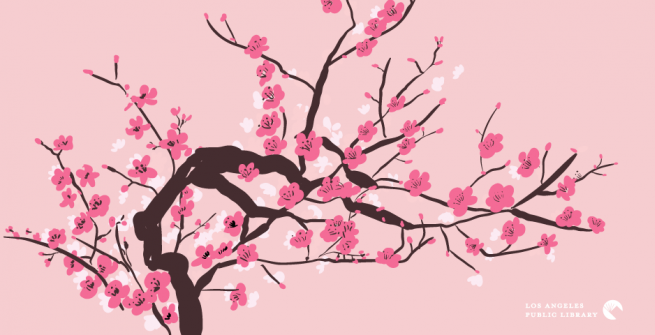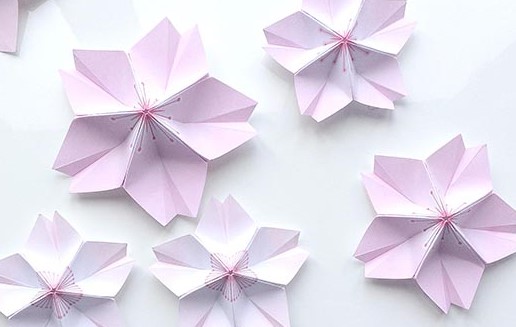Are you ready for a springtime of cherry blossoms? Like the countless petals carpeting the ground beneath the cherry tree, there are many ways to enjoy celebrating the return of warm sunshine, cool breezes, and the pale shades of pink of these five-petal flowers. We can create our own festival of cherry blossoms through the art of paper folding called Origami.
If you have square Origami paper, which holds a crease when you fold it, and color on only one side, that will do; brown wrapping paper works beautifully too. Begin with learning a few simple folds that Mari Ono shares in her book, Origami for Children.
Many artists, following tradition, use only a square of paper to make their designs, while others use paper folding techniques along with a snip of the scissors and a drop of glue to turn a flat piece of paper into a three dimensional art form. Robert Neale and Thomas Hull use a variety of methods in their book, Origami, Plain and Simple.
Before we begin creating our own cherry blossoms, let’s explore the tree’s history. Every spring, cherry blossoms are in full bloom not only in Asia, but also in North America and Europe. In Japan, traditionally, people gather underneath blooming cherry trees in parks and even in the mountains to have a Hanami, Cherry Blossom viewing party, and in shrines they observe and reflect on the beauty of the cherry trees in bloom. It is a time of popular and beloved spring festivals in Japan.
The most popular cherry blossom tree variety for Hanami is the Yoshino cherry tree with its pale pink petals. Gordon Melton describes the reasons why the Yoshino cherry tree is loved as “It produces an amazing amount of blossoms, but very few seeds, and must be propagated from cuttings. Its blossom is also very short lived, and this contributed to its symbolic nature as a sign of the brevity of life.”
We can enjoy the Yoshino cherry trees here in the United States too. In 1912, the Mayor of Tokyo gave 3,020 Yoshino cherry trees as a sign of friendship between Japan and America. They were planted in the surrounding area of the Tidal Basin in Washington, D.C. where the annual Washington Cherry Blossom Festival takes place. In 1965, the Japanese government gave another 3,800 trees as a gift. Years later when a flood damaged many of the cherry trees in Japan, America shared cuttings from their Japanese gift trees to help our ally begin the process of replanting.
Now try your hand at making a cherry blossom from Naomiki Sato’s Origami Roses: Create Lifelike Roses and Other Blossoms. Naomiki, who uses traditional folding techniques, grew up in rural Japan where his father was a botany professor. There at an early age Naomiki observed and drew flowers. He took inspiration from the works of the Belgian painter and botanist, Pierre-Joseph Ladouté. Naomiki now lives in France, is a member of the French Origami Society, and creates flowers that are so exquisite you lean in to catch their scent.
Hiromi Yamazaki uses both traditional and cutting techniques for her delicate cherry blossoms in Japanese Paper Flowers: Elegant Kirigami Blossoms, Bouquets, Wreathes and More. Hiromi shares her art at a floral paper art shop in Tokyo.
Making models from paper is a time honored practice that began, perhaps, with the making of paper in China around 105 CE by a Chinese official, Cai Lun. Sometime between 550- 610 AD the Japanese were also creating hand-made paper that they had learned to craft when visitors from Korea shared their methods.
If we read a poem by Saikaku in 1680, we would have discovered a written reference to a paper creation in the form of a paper-folded butterfly. Michael LaFosse has been paper folding for decades and in his book with Richard Alexander, he shares diagrams, photographs and the story of first learning to fold a butterfly designed by Akira Yoshizawa, a Japanese master paper folder. Just for inspiration, check out Michael’s own models in Origami Butterflies.
By the 1800’s paper folding was used in kindergartens in Europe, and a doctor in Argentina, Vicente Solorzano Sagredo, spread the art form in South America. All the while Akira Yoshizawa in the mid-1900s devised a way to diagram his folding techniques so that others could learn this art. Lillian Oppenheimer, an American born in 1898, learned to paper-fold and used two roots of words in the Japanese language oru and kami, to describe this art form and the organization she helped to establish, now called OrigamiUSA, which has offices at the Museum of Natural History in New York City.
Today there are Origami organizations around the world with member artists, scientists, and mathematicians in every corner of the globe who practice paper folding to understand the principles of flight, to design creatures for stop-motion films, and to welcome spring each year at the time of the Cherry Blossom Festival.










